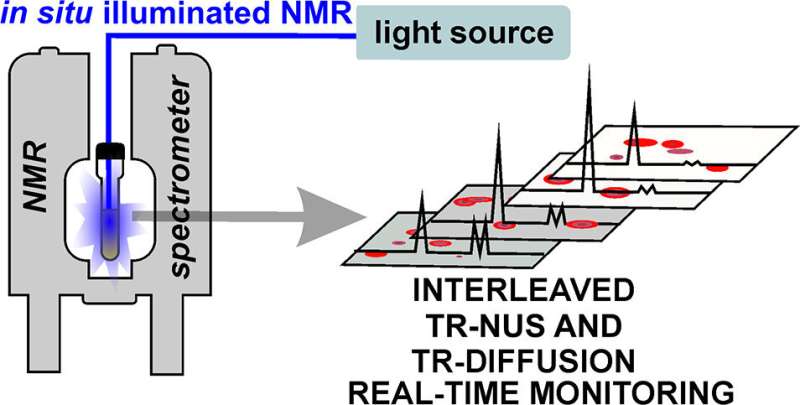Researchers combine two NMR-based methods to understand the photopolymerization process

To design novel materials, scientists need to have a clear understanding of the chemical reactions or processes that take place when these materials are created. Researchers supported in part by the PD2PI project have now combined two novel NMR-based monitoring methods, making it possible to gain deeper insight into complex chemical processes such as photopolymerization. Their findings are described in the Journal of the American Chemical Society.
In polymerization processes—where small molecules called monomers combine to form a very large chain or 3D network called a polymer—knowing what is happening during the reaction would make it much easier to tune the process for product development. This is also true for photopolymerization processes that use visible or ultraviolet light to induce a polymerization reaction that forms a polymer structure.
Two NMR-based methods for comprehensive monitoring
However, how does one obtain in-depth information on the molecular structure of various solids and liquids? One of the most comprehensive ways is through NMR measurements. For this study, the researchers combined two NMR-based reaction monitoring methods that had never before been used together to analyze a particular system: time-resolved diffusion NMR and time-resolved non-uniform sampling.
The first method allows the average diffusion coefficient of the particular chemicals to be measured, while the second makes it possible to monitor the formation of products. Their findings indicate that combining the two methods is an excellent way to comprehensively monitor photopolymerization.
To demonstrate the potential of their approach, the team avoided using an overly simplified model to monitor, instead choosing the photopolymerization of an aromatic bis-anthracene derivative—N,N-bis(anthracen-9-ylmethyl)butane-1,4-diamine (H2banthbn). "
In our work, a photopolymerization of bis-anthracene-based systems was chosen. The system is very interesting for employing building blocks during polymerization that can be helpful for the design of various photofunctional materials," says study senior author Dr. Mateusz Urbańczyk of PD2PI, a project coordinator from the Institute of Physical Chemistry of the Polish Academy of Sciences.
Employing the different methods at the same time helped to provide a correlation between particular features of the system and information that cannot be obtained when the two methods are used separately. The authors explain in the article that "the synergy between both time-resolved methods allows us to understand the photopolymerization process of H2banthbn. Using only diffusion methods, we would have only a crude idea about the average mass of the system, and obtaining the information about particular n-mers would be close to impossible."
"The HSQC data allow us to track the concentration changes of each n-mer, providing us with quite compelling information about the system. That being said, the assignment of the peaks without the confirmation from the diffusion data would be ambiguous. The use of both methods allows us to have certainty about the assignment and, therefore, to better understand the system."
"Finally, the presented comprehensive methodology was demonstrated on a challenging system in terms of concentration, line widths, and magnetic field. The presented approach is general and can be used for different types of chemical reactions, especially the polymerization reactions and photoreactions."
More information: Kristina Kristinaityte et al, Deeper Insight into Photopolymerization: The Synergy of Time-Resolved Nonuniform Sampling and Diffusion NMR, Journal of the American Chemical Society (2022). DOI: 10.1021/jacs.2c05944
Journal information: Journal of the American Chemical Society
Provided by CORDIS




















